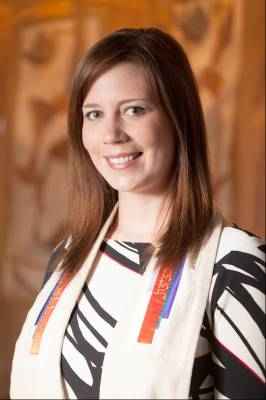
As with any good architectural design, this Torah portion offers precise instructions. Parashat T’rumah lays out a manual for building our place of worship in the desert (known as the Mishkan) along with all of the instruments contained within. It details exact measurements, materials, and methods of construction. The instructions were intended to be foolproof and impossible to misinterpret. But there appears to be some daylight between the original concept and the final product — at least with one very important element: the menorah.
Even more than the Star of David, the menorah is the symbol that has long been synonymous with the Jewish people. It is the central image in the official seal of the State of Israel.
The Torah portion spells out the exact specifications for how to build it: how many branches should have, what materials it should be constructed from, where the branches should be placed and how they should be decorated. It’s hard to imagine with this kind of detail that the blueprint could be interpreted in any way other than the image that we have today. Indeed, the modern-day seal of Israel looks very similar to one of the earliest surviving depictions of the menorah in the Arch of Titus in Rome. That arch was commissioned a mere 12 years after the destruction of the Temple for Rome to celebrate the conquering of Jerusalem. It’s easy to imagine that maybe the artist’s rendition came from a firsthand view of the original.
Then 1100 years later, Maimonides offered a version of what he thought the menorah looked like. Here, the arms are straight diagonals rather than curved branches as depicted in the Arch of Titus. Maimonides interpreted the menorah to look very different than the earlier depiction in the Arch of Titus would suggest. Moreover, in a commentary on Exodus 25:32, Rashi seems to agree with Maimonides that the branches are straight diagonals.
It should be stated that Rashi and Maimonides are probably the most recognized giants of medieval Jewish tradition. They certainly were not lazy or careless in their reading of the text. But after a millennium had passed since the Temple stood, with no firsthand reports to rely upon, these rabbinic giants were fully dependent on the instruction of the Torah portion to provide the picture for them.
Maimonides and Rashi probably got it wrong. And it was not their fault. Nothing about their interpretation with the diagonal branches contradicts the text in our Torah portion. The ambiguity rests within the original instructions. As clear as our ancestors thought they were being with their instructions to future generations, they had an idea in their heads that they did not fully communicate.
We sometimes find ourselves in scenarios of incomplete communication that are not all that different. Case in point: I oversaw an interfaith program where participants sat back-to-back in pairs and were handed identical envelopes filled with paper shapes. One person would a design with these shapes and then the other — facing the opposite direction and relying only on the instructions of the designer — would attempt to replicate the design.
Inevitably, when the results were revealed, the designing partners would turn to see mangled versions of their original designs created by the other partners. They were shocked by the failure of their partners to listen. But they quickly realized that they were at fault for leaving out key details — which point of the triangle rests against the square or what direction the corners of the square should face.
The exercise provides a profound lesson about the disconnect between what we think we’re communicating and what we actually say. The fact that our ancestors suffered the same problem in constructing our most sacred text provides some level of comfort. If the construction of the Mishkan was of cosmic significance for our ancestors and they didn’t successfully communicate that to future generations, think about how frequently our imprecisions in communication impact our work and our relationships.
The surface lesson we can take from this is to pay more attention to our communication — to try to be more precise. And that’s certainly a fair lesson. All of us could step up our game in how we communicate to our family, friends, and coworkers. But there’s a more important lesson here because these kinds of miscommunications are inevitable on some level. And the real lesson lies in how we handle these moments of miscommunication. We are often certain of our clarity. We are shocked when someone takes what we said out of context, misinterprets, or misunderstands. We may find ourselves quick to blame someone else for not listening well enough.
But knowing how hard it is to avoid miscommunication, perhaps we would be better served by reserving judgement when it happens. What if we didn’t automatically assume that it was the other person’s fault when something goes wrong? What if we asked ourselves first what we may have communicated better? There are times when we are on the perpetrating end and times when we are on the receiving end of fumbled communication. Either way, our ancestors’ experience with the menorah gives us an invitation to understand the limits of communication. Perhaps, this story about a (mis)interpretation of the menorah can serve as an invitation for a bit of humility in our conversations and communication today.
Rabbi Sarah Bassin is the associate rabbi at Temple Emanuel of Beverly Hills, in Beverly Hills, CA and former executive director and board member of NewGround: A Muslim-Jewish Partnership for Change.
 Rabbi Bassin’s message on T’rumah regarding miscommunication is even more expansive when we look at other forms of modern communication besides speech. Today’s standard communication for businesses, as well as personal use, is often delivered via email or text message. By using these modern conveniences, we put our message at risk. There is no tone of voice in email or text messaging except the tone that the reader substitutes for our own, which causes countless issues. As Rabbi Bassin states, “We are shocked when someone takes what we said out of context, misinterprets, or misunderstands.” How many times have we sent an email in a hurry only to appear to the reader curt, unfeeling, or dismissive? How many times have we sent an email with compassion only to have the reader find it condescending? Like Rashi and Maimonides, the reader sees the email from their perspective, missing the complexity and ambiguity within. Maimonides sketched the menorah more than 1100 years after the destruction of the Temple, so we can understand why he possibly got it wrong. But an email sent one second ago has the same danger of being misunderstood, even if the reader was “not lazy or careless in their reading of the text.”
Rabbi Bassin’s message on T’rumah regarding miscommunication is even more expansive when we look at other forms of modern communication besides speech. Today’s standard communication for businesses, as well as personal use, is often delivered via email or text message. By using these modern conveniences, we put our message at risk. There is no tone of voice in email or text messaging except the tone that the reader substitutes for our own, which causes countless issues. As Rabbi Bassin states, “We are shocked when someone takes what we said out of context, misinterprets, or misunderstands.” How many times have we sent an email in a hurry only to appear to the reader curt, unfeeling, or dismissive? How many times have we sent an email with compassion only to have the reader find it condescending? Like Rashi and Maimonides, the reader sees the email from their perspective, missing the complexity and ambiguity within. Maimonides sketched the menorah more than 1100 years after the destruction of the Temple, so we can understand why he possibly got it wrong. But an email sent one second ago has the same danger of being misunderstood, even if the reader was “not lazy or careless in their reading of the text.”
The Talmud says that God provided the tongue with “two walls, one of bone and one of flesh,” in order to guard our speech (Babylonian Talmud, Arachin 15b). This is all fine and good, except that these days, the majority of communication happens through typing. It turns out that God gave us two hands, and nothing to guard them. It would be best for us to remember Rabbi Bassin’s lesson, that even the great masters got it wrong, due to their disadvantages, and that perhaps if we recognize the ambiguity in speech through text, we can write with more care, and read with more compassion.
Rabbi Michael Harvey is the rabbi at Temple Israel in West Lafayette, IN.
T’rumah, Exodus 25:1-27:19
The Torah: A Modern Commentary, pp. 604-611; Revised Edition, pp. 543-558
The Torah: A Women’s Commentary, pp. 451-472
Haftarah I Kings 5:26-6:13
The Torah: A Modern Commentary, pp.717-718; Revised Edition, 559-560


